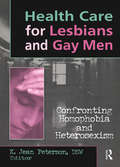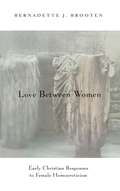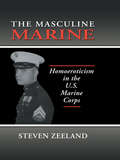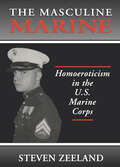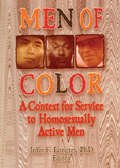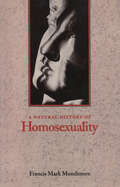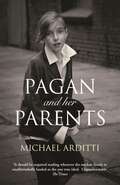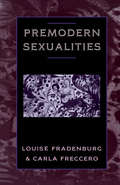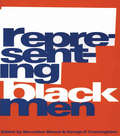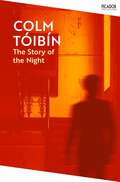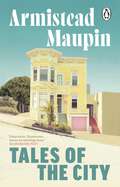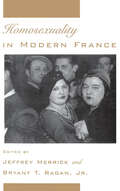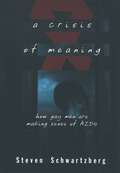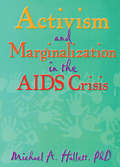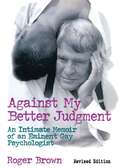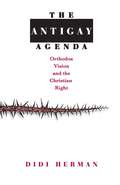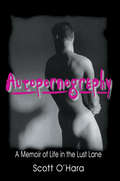- Table View
- List View
Health Care for Lesbians and Gay Men: Confronting Homophobia and Heterosexism
by K Jean PetersonHealth Care for Lesbians and Gay Men educates practitioners about the special needs of gay and lesbian patients and how to look critically at the impact of homophobia and heterosexism on the provision of care. It provides an overview of critical health care issues for lesbians and gay men and offers concrete suggestions to health practitioners and social workers on how to address these issues in order to guarantee the best care for their patients and clients. Authors in Health Care for Lesbians and Gay Men give health care providers and mental health workers practical interventions; suggestions for advocacy, social change, grassroots efforts, and alternative programs; and lessons about how to use existing procedures to more effectively meet the unique health care needs of gays and lesbians. Practitioners also learn how to utilize legal action in securing and protecting patients’and clients’personal health care wishes. Chapters in this book cover: how homophobia and negative attitudes can directly compromise the care given to lesbians and gay men. heterosexism and biases which exclude the partners of gay men and lesbians from participating in the care of their loved ones. legal issues and the need for legal recognition of gay and lesbian relationships, both to enhance the provision of care and for financial access to health care presently available to only heterosexual, married couples. legal protection and special legal documents that ensure that the wishes of gay men and lesbians are honored and the integrity of their relationships not violated.Health Care for Lesbians and Gay Men starts with special issues confronting adolescents and the special role health care providers can play in supporting the struggles of lesbian and gay adolescents. It then continues to look at these issues over the life cycle. Three themes emerge as authors try to explain problems and possible solutions for lesbians and gay men seeking health care: the pervasive homophobia and heterosexism found throughout the health care system and the impact these attitudes and beliefs have on the health care of lesbians and gay men; the need for education in professional programs on special health issues of gay men and lesbians; and the critical role that social workers can play in both educating others about the special needs of their gay and lesbian clients and in advocating for their clients in various health care settings.Health Care for Lesbians and Gay Men is essential reading for social work and social service practitioners and students working in the health care field, advanced undergraduates and graduate students of social work, professionals and students of nursing and medicine, and others concerned with the quality and equality of health care services. It urges students and professionals to challenge and evaluate their own attitudes, beliefs, and behaviors in order to ensure quality services to all clients and patients.
Health Care for Lesbians and Gay Men: Confronting Homophobia and Heterosexism
by K Jean PetersonHealth Care for Lesbians and Gay Men educates practitioners about the special needs of gay and lesbian patients and how to look critically at the impact of homophobia and heterosexism on the provision of care. It provides an overview of critical health care issues for lesbians and gay men and offers concrete suggestions to health practitioners and social workers on how to address these issues in order to guarantee the best care for their patients and clients. Authors in Health Care for Lesbians and Gay Men give health care providers and mental health workers practical interventions; suggestions for advocacy, social change, grassroots efforts, and alternative programs; and lessons about how to use existing procedures to more effectively meet the unique health care needs of gays and lesbians. Practitioners also learn how to utilize legal action in securing and protecting patients’and clients’personal health care wishes. Chapters in this book cover: how homophobia and negative attitudes can directly compromise the care given to lesbians and gay men. heterosexism and biases which exclude the partners of gay men and lesbians from participating in the care of their loved ones. legal issues and the need for legal recognition of gay and lesbian relationships, both to enhance the provision of care and for financial access to health care presently available to only heterosexual, married couples. legal protection and special legal documents that ensure that the wishes of gay men and lesbians are honored and the integrity of their relationships not violated.Health Care for Lesbians and Gay Men starts with special issues confronting adolescents and the special role health care providers can play in supporting the struggles of lesbian and gay adolescents. It then continues to look at these issues over the life cycle. Three themes emerge as authors try to explain problems and possible solutions for lesbians and gay men seeking health care: the pervasive homophobia and heterosexism found throughout the health care system and the impact these attitudes and beliefs have on the health care of lesbians and gay men; the need for education in professional programs on special health issues of gay men and lesbians; and the critical role that social workers can play in both educating others about the special needs of their gay and lesbian clients and in advocating for their clients in various health care settings.Health Care for Lesbians and Gay Men is essential reading for social work and social service practitioners and students working in the health care field, advanced undergraduates and graduate students of social work, professionals and students of nursing and medicine, and others concerned with the quality and equality of health care services. It urges students and professionals to challenge and evaluate their own attitudes, beliefs, and behaviors in order to ensure quality services to all clients and patients.
Love Between Women: Early Christian Responses to Female Homoeroticism (Chicago Series on Sexuality, History, and Society)
by Bernadette J. BrootenLove Between Women examines female homoeroticism and the role of women in the ancient Roman world. Employing an unparalleled range of cultural sources, Brooten finds evidence of marriages between women and establishes that condemnations of female homoerotic practices were based on widespread awareness of love between women. "An extraordinary accomplishment. . . . A definitive source for all future discussion of homoeroticism and the Bible."—Mary Rose D'Angelo, Harvard Gay & Lesbian Review "[Brooten's] convincing analysis . . . not only profoundly reshapes our understanding of the past, but it should also shape the way in which that past, particularly the early Christian texts with their immense normative weight, will be used for the future."—Anne L. Clark, Journal of Lesbian Studies "Love Between Women gives contemporary debates on sexuality a carefully delineated past. It boldly insists upon a different future, one informed by history but not tyrannized by it."—Susan Ackerman, Lambda Book Report "Fascinating, provocative and lucid. . . . Brooten has made a fundamental contribution to women's and gender studies, gay and lesbian studies, and classics."—Elizabeth A. Castelli, Women's Review of Books Winner of the Lambda Literary Award for Best Lesbian Studies Book, 1997
The Masculine Marine: Homoeroticism in the U.S. Marine Corps
by Steven ZeelandThis exciting book was listed as #1 on The Advocate’s (ital) bestseller list for December 1996! In The Masculine Marine, author Steven Zeeland records, for the first time ever, what active-duty Marines have to say about what it means to be a man, to be a Marine, and to desire other men. As the foremost surviving icon of traditional masculinity, Marines are often considered the opposite of “gay.” Yet in contemporary gay culture, Marines are stereotyped as likely to play the passive role in sexual encounters with other men. By vividly illustrating some of the startling ways in which gay and Marine attributes can coincide, The Masculine Marine uncovers the wild sexual contradictions built into military hypermasculinity. From ordinary grunts to a major who flies a combat jet, Zeeland’s Marine interviewees provide thoughtful and articulate insight into aspects of this rarely documented culture, including: homoerotic bonding among Marines how gay Marines reconcile their sexual identity with the ethos of “hard” Marine supermasculinity how some Marines eroticize the pain and humiliation of Marine Corps boot camp Marines in all-male pornography male attitudes toward women in the Marine Corps hazing and institutional violence These Marines talk candidly about what motivated them to join the United States’most elite fighting force, and they reveal how becoming Marines has shaped their sexual and gender identities. For the student of gay or military studies or anyone sexually intrigued by men in uniform, The Masculine Marine must reading. Visit Steven Zeeland at his home page: http://www.stevenzeeland.com
The Masculine Marine: Homoeroticism in the U.S. Marine Corps
by Steven ZeelandThis exciting book was listed as #1 on The Advocate’s (ital) bestseller list for December 1996! In The Masculine Marine, author Steven Zeeland records, for the first time ever, what active-duty Marines have to say about what it means to be a man, to be a Marine, and to desire other men. As the foremost surviving icon of traditional masculinity, Marines are often considered the opposite of “gay.” Yet in contemporary gay culture, Marines are stereotyped as likely to play the passive role in sexual encounters with other men. By vividly illustrating some of the startling ways in which gay and Marine attributes can coincide, The Masculine Marine uncovers the wild sexual contradictions built into military hypermasculinity. From ordinary grunts to a major who flies a combat jet, Zeeland’s Marine interviewees provide thoughtful and articulate insight into aspects of this rarely documented culture, including: homoerotic bonding among Marines how gay Marines reconcile their sexual identity with the ethos of “hard” Marine supermasculinity how some Marines eroticize the pain and humiliation of Marine Corps boot camp Marines in all-male pornography male attitudes toward women in the Marine Corps hazing and institutional violence These Marines talk candidly about what motivated them to join the United States’most elite fighting force, and they reveal how becoming Marines has shaped their sexual and gender identities. For the student of gay or military studies or anyone sexually intrigued by men in uniform, The Masculine Marine must reading. Visit Steven Zeeland at his home page: http://www.stevenzeeland.com
Men of Color: A Context for Service to Homosexually Active Men
by John LongresMen of Color provides those working in the social services with an assessment framework for identifying and understanding the developmental needs of gay and bisexual men of color. By adding an ethnic dimension to the literature on homosexual conduct and identity, this book helps service providers improve services for men from all communities. It provides insightful implications for practice and programs, presenting valuable, practical information for planning services for African-, Asian-, Latino-, and Native Americans.Chapters in Men of Color gives you a context for working with homosexually active men of color, regardless of their specific service needs. This broad base is constructed by showing that the meaning of homosexual conduct and identity changes across cultures and generations; that the gay rights movement is having a profound impact on all ethnic/racial communities; that although the pull toward the gay community is strong, the pull to retain ethnic identities is equally strong; and that homosexuality varies culturally and historically. Contributors give: a cross-cultural comparison of identity, networks, and social support patterns among European-, African-, and Latino American men seeking services from an HIV prevention program. an ecological assessment model that can be used by social service professionals working with African American men. an historically-based description of Native American men that ends with their own special vision for clinical services. a review of the literature on Latin American and Filipino men. an historical examination of Korean norms and attitudes on homosexuality. a discussion of an applied research agenda for gay men of color that derives from the need to improve delivery of social services.Men of Color asserts that homosexually active men of color are often caught in a dilemma: they must choose between their ethnic and sexual identities, either putting their ethnicity before their gayness, or their gayness before their ethnicity. The book predicts that the lure of sexual freedom, coupled with the comfort of old traditions, will lead to a new synthesis of gay and ethnic identities and helps service providers facilitate this synthesis. Whether you’re a social service provider, social work or health educator, or gay/lesbian studies educator, you will find Men of Color a superior guide for improving your services.
Men of Color: A Context for Service to Homosexually Active Men
by John LongresMen of Color provides those working in the social services with an assessment framework for identifying and understanding the developmental needs of gay and bisexual men of color. By adding an ethnic dimension to the literature on homosexual conduct and identity, this book helps service providers improve services for men from all communities. It provides insightful implications for practice and programs, presenting valuable, practical information for planning services for African-, Asian-, Latino-, and Native Americans.Chapters in Men of Color gives you a context for working with homosexually active men of color, regardless of their specific service needs. This broad base is constructed by showing that the meaning of homosexual conduct and identity changes across cultures and generations; that the gay rights movement is having a profound impact on all ethnic/racial communities; that although the pull toward the gay community is strong, the pull to retain ethnic identities is equally strong; and that homosexuality varies culturally and historically. Contributors give: a cross-cultural comparison of identity, networks, and social support patterns among European-, African-, and Latino American men seeking services from an HIV prevention program. an ecological assessment model that can be used by social service professionals working with African American men. an historically-based description of Native American men that ends with their own special vision for clinical services. a review of the literature on Latin American and Filipino men. an historical examination of Korean norms and attitudes on homosexuality. a discussion of an applied research agenda for gay men of color that derives from the need to improve delivery of social services.Men of Color asserts that homosexually active men of color are often caught in a dilemma: they must choose between their ethnic and sexual identities, either putting their ethnicity before their gayness, or their gayness before their ethnicity. The book predicts that the lure of sexual freedom, coupled with the comfort of old traditions, will lead to a new synthesis of gay and ethnic identities and helps service providers facilitate this synthesis. Whether you’re a social service provider, social work or health educator, or gay/lesbian studies educator, you will find Men of Color a superior guide for improving your services.
A Natural History of Homosexuality
by Francis Mark MondimoreA terrible sin, a gift from the gods, a mental illness, a natural human variation—over the centuries people have defined homosexuality in all of these ways. Since the word homosexual was coined in 1869, many scientists in a variety of fields have sought to understand same-sex intimacy. Drawing on recent insights in biology and genetics, psychiatrist Francis Mondimore set out to explore the complex landscape of sexual orientation.The result is A Natural History of Homosexuality, a generous work that synthesizes research in biology, history, psychology, and politics to explain how homosexuality has been understood and defined from ancient times until the present. Mondimore narrates tales of love and courage as well as discrimination and bigotry in settings as diverse as ancient Greece and Victorian England, early America and fin de siecle Vienna. He also tells fascinating stories about societies which accepted, incorporated, or institutionalized homosexuality into mainstream culture, stories illustrating that same-sex eroticism was often accepted as a normal aspect of human sexuality. In twentieth-century America, researchers first recognized that homosexuality might not be "pathological" when Alfred Kinsey and Evelyn Hooker conducted the first studies of sexuality not biased by preconceived notions of "normal" sexual behavior. After exploring sexual development in the human fetus, Mondimore reviews current biological research into the nature of sexual orientation and examines recent scientific findings on the role of heredity and hormones, as well as Simon LeVay's 1991 brain studies. He then turns to a very important focus: on people and their individual experiences. He explores "what happens between childhood and adulthood in an individual that makes him or her come to identify himself or herself as having a sexual orientation." He also explains our current understanding of bisexuality and the transgender phenomena of transsexualism and transvestism. Finally, Mondimore analyzes the circumstances of such prominent scandals as the anti-homosexual trials of Oscar Wilde and Philip von Eulenberg, and recounts the Nazi persecution of homosexuals during the Holocaust. This far-reaching discussion includes a description of the ex-gay ministries and reparative therapy as well as the Stonewall riots and AIDS, ending with the emergence of gay pride and community.
Pagan and Her Parents
by Michael ArdittiA powerful novel about a gay man's struggle to adopt the daughter of his late best friend'Unputdownable' The Times'Arditti writes exactly like Dickens' Scotland on Sunday'I honestly couldn't put the book down' Literary ReviewCandida Mulliner and Leo Young have been the closest of friends since university, living together but loving separately. When Candida dies after a long illness, she leaves her five year old daughter, Pagan, in Leo's care. Candida's adoptive parents are horrified; they refuse to accept that a single man is a suitable person to bring up a child and challenge Leo's guardianship in the courts. The ensuing hearings are complicated by tabloid exposure of Leo's homosexuality, which threatens not only his position with Pagan but also his job as a television chat-show host. As Leo fights for his and Pagan's rights in a society that continues to regard gay men as a threat to children, he finds himself isolated, vilified and, ultimately, arrested. Meanwhile, he endeavours to discover the truth about Candida, the cause of her estrangement from her adoptive parents, the identity of her natural mother and the reason for her refusal to name Pagan's father.
Premodern Sexualities
by Louise Fradenburg Carla FrecceroPremodern Sexualities offers rigorous new approaches to current problems in the historiography of sexuality. From queer readings of early modern medical texts to transcribing and interrogating premodern documents of sexual transgression, the contributors bring together current theoretical discourses on sexuality while emphasizing problems in the historicist interpretation of early textualizations of sexuality. Premodern Sexualities clarifies the contributions literary studies can make--through its emphasis on reading strategies--to the historiography of sexuality.
Premodern Sexualities
by Louise Fradenburg Carla FrecceroPremodern Sexualities offers rigorous new approaches to current problems in the historiography of sexuality. From queer readings of early modern medical texts to transcribing and interrogating premodern documents of sexual transgression, the contributors bring together current theoretical discourses on sexuality while emphasizing problems in the historicist interpretation of early textualizations of sexuality. Premodern Sexualities clarifies the contributions literary studies can make--through its emphasis on reading strategies--to the historiography of sexuality.
Representing Black Men
by Marcellus Blount George CunninghamRepresenting Black Men focuses on gender, race and representation in the literary and cultural work of black men.
Representing Black Men
by Marcellus Blount George P. CunninghamRepresenting Black Men focuses on gender, race and representation in the literary and cultural work of black men.
The Story of the Night (Picador Collection #102)
by Colm Tóibín'Beautiful . . . a thriller, a love story and much more' Roddy Doyle'A remarkable achievement . . . [a] sheer pleasure to read' The Sunday TimesRichard Garay lives alone with his mother in Buenos Aires, hiding his sexuality from her and the world. Stifled by a job he despises, he finds himself willing to take considerable risks. Set in Argentina in a time of great change, The Story of the Night by Colm Tóibín is a powerful and moving novel about sex, death, and a man who, as the Falklands War is fought and lost, finds his own way to emerge into the world.
Tales Of The City: Tales Of The City 1 (Tales of the City #1)
by Armistead MaupinThe first novel in the beloved Tales of the City series, Armistead Maupin’s best-selling San Francisco saga, is an uproariously moving novel and an indelible portrait of cultural change from the seventies.Named as one of the BBC’s 100 Most Inspiring Novels, a PBS Great American Read Top 100 Pick and Britain’s favourite gay/lesbian novel from The Big Gay Read____________________Originally serialised in the San Francisco Chronicle in the 1970s, Armistead Maupin’s Tales of the City afforded a mainstream audience of millions its first exposure to straight and gay characters experiencing on equal terms the follies of urban life.Among the cast of this ground-breaking saga are the lovelorn residents of 28 Barbary Lane: the bewildered but aspiring Mary Ann Singleton, the libidinous Brian Hawkins; Mona Ramsey, still in a sixties trance, Michael 'Mouse' Tolliver, forever in bright-eyed pursuit of Mr. Right; and their marijuana-growing landlady, the indefatigable Mrs. Madrigal.Hurdling barriers both social and sexual, Maupin leads them through heartbreak and triumph, through nail-biting terrors and gleeful coincidences. The result is a glittering and addictive comedy of manners that continues to beguile new generations of readers.
Homosexuality in Modern France (Studies in the History of Sexuality)
by Jeffrey Merrick Bryant T. RaganThis volume explores the realities and representations of same-sex sexuality in France in the eighteenth, nineteenth, and twentieth centuries, the period that witnessed the emergence of "homosexuality" in the modern sense of the word. Based on archival research and textual analysis, the articles examine the development of homosexual subcultures and illustrate the ways in which philosophes, pamphleteers, police, novelists, scientists, and politicians conceptualized same-sex relations and connected them with more general concerns about order and disorder. The contributors--Elizabeth Colwill, Michael David Sibalis, Victoria Thompson, William Peniston, Vernon Rosario II, Francesca Canade-Sautman, Martha Hanna, Robert A. Nye, and the editors Bryant T. Ragan, Jr. and Jeffrey Merrick--use the methods of intellectual and cultural history, the history of science, literary studies, legal and social history, and microhistory. This collection shows how the subject of homosexuality is related to important topics in French history: the Enlightenment, the revolutionary tradition, social discipline, positivism, elite and popular culture, nationalism, feminism, and the construction of identity. Given the role of gays and lesbians in modern French culture and the work of French scholars on the history of sexuality, this collection fills an important gap in the literature and represents the first attempt in any language to explore this subject over three centuries from a variety of perspectives.
A Crisis of Meaning: How Gay Men Are Making Sense of AIDS
by Steven SchwartzbergFor gay men, the demands of the AIDS epidemic are enormous and unrelenting. Regardless of HIV status, all are called on to maintain vigilant safety with sex, to face down a cultural stigma greater even than homophobia, and to somehow find a way to go forward in a world heavy with loss. As exhaustion and grief threaten to overwhelm the activism and optimism of earlier years, and with new infections on the rise among young gay men, the challenge of finding meaning in a world turned upside down is more than an idle philosophical exercise. It is a matter of psychological and perhaps even physical survival. In this poignant and uncompromising new book, Dr. Steven Schwartzberg offers a ground-breaking perspective on how gay men (and particularly HIV-positive gay men) find ways to rebuild a world of meaning amid the trauma and uncertainty of the AIDS crisis. Eschewing both glib prescriptions for turning tragedy into triumph, and theoretical abstractions, Schwartzberg grounds his insights in his own experiences as a gay man and as a practicing psychotherapist, and in in-depth interviews with nineteen men living with HIV. Ranging in age from twenty-seven to fifty, the men include a construction foreman, a physician, an art historian, a waiter, a librarian, and a licensed massage therapist. With candor, insight, eagerness, and a remarkable ability to share of themselves, they speak eloquently about how HIV has affected their views of the world, their senses of themselves, and how they live their lives. Interweaving the men's stories with observations from his research and clinical practice, Schwartzberg bears witness to the remarkable transformations some men have accomplished, and the anguish of meaninglessness that weighs others down. He strives to uncover why some view HIV as a catalyst for change or growth, while others see it only as punishment. And though he passes no judgment on the coping strategies he describes, Schwartzberg does insist on the vital necessity of balancing somber reality with healing, life-sustaining hope. He argues that men who opt for too much illusion and too little reality risk shoddy self-care and inadequate preparation for the future, while those who find no escape from reality may teeter into rage or suicidal despair. Beautifully written, with piercing awareness of the enormity of the challenges confronting individuals with HIV, this book celebrates the resilience of the human spirit. It is both a keen psychological guide and an elegiac chronicle of what life for many has become. Gently pointing the way to an oasis of growth, strength, and love that exists amid the epidemic's bleak terrain of loss, it is essential reading for people living with HIV, for their friends, families, and the mental health professionals who care for them, and for all gay men grappling with the enormous changes AIDS has brought to a community under siege.
Activism and Marginalization in the AIDS Crisis
by Michael A HallettActivism and Marginalization in the AIDS Crisis shows readers how the advent of HIV-disease has brought into question the utility of certain forms of “activism” as they relate to understanding and fighting the social impacts of disease. This informative and powerful book is centrally concerned about the ways in which institutionally governed social constructions of HIV/AIDS affect policy and public images of the disease more so than activist efforts. It asserts that an accounting of the power institutional structures have over the dominant social constructions of HIV disease is fundamental to adequate forms of present and future AIDS activism. Chapters in Activism and Marginalization in the AIDS Crisis demonstrate how, despite what is thought of as the “successful activism” of the past decade, the claims of the HIV-positive are still being ignored, still being marginalized, and still being administratively “handled” and exploited even as the plight of those who find themselves HIV-positive worsens. Although chapters reject the assertion that activism has been a highly effective remedy to HIV-positive voicelessness, authors do not deny that activists have been vocal, but that they continue to be ignored despite their vocality.Contributors in Activism and Marginalization in the AIDS Crisis offer numerous examples of institutional control and demonstrate that institutional structures, and not activists, are controlling the public meaning of HIV-related issues. Readers learn how messages about HIV/AIDS are produced, negotiated, modified, and sustained through institutional mechanisms that serve mostly institutional interests rather than those of the HIV-positive. In gaining an understanding of these issues, readers will begin to learn how to modify and strengthen activist efforts with valuable insight on: the lack of HIV-positive voices in mainstream news portrayals of HIV/AIDS research on constructions of HIV-disease at the state government level social constructions and how they affect HIV/AIDS policy the political construction of AIDS and interest-based struggles the emergent “bio-politics” of HIV and homosexuality in the U.S. how institutional power works to govern public understanding of HIV diseaseInstitutional structures are defined in this book as groups engaged in and defined by the production of various “truths” which sustain them. Institutional power may be defined as the capacity to regulate, constrain, and disseminate versions of “truth.” Activism and Marginalization in the AIDS Crisis reveals how HIV activist groups have been outmaneuvered when it comes to the production and dissemination of various “truths” about HIV/AIDS by institutional structures more deeply steeped in social legitimacy and which have a superior capacity for message dissemination.HIV/AIDS activists, HIV-positive persons and those with AIDS, HIV/AIDS educators, public and institutional policymakers, health professionals, and the general public will find this book essential to understanding the social constructions of HIV/AIDS, how these affect HIV/AIDS-related policy and public opinion, and how to begin to cipher through the plethora of information to find and promote the “truth.”
Activism and Marginalization in the AIDS Crisis
by Michael A HallettActivism and Marginalization in the AIDS Crisis shows readers how the advent of HIV-disease has brought into question the utility of certain forms of “activism” as they relate to understanding and fighting the social impacts of disease. This informative and powerful book is centrally concerned about the ways in which institutionally governed social constructions of HIV/AIDS affect policy and public images of the disease more so than activist efforts. It asserts that an accounting of the power institutional structures have over the dominant social constructions of HIV disease is fundamental to adequate forms of present and future AIDS activism. Chapters in Activism and Marginalization in the AIDS Crisis demonstrate how, despite what is thought of as the “successful activism” of the past decade, the claims of the HIV-positive are still being ignored, still being marginalized, and still being administratively “handled” and exploited even as the plight of those who find themselves HIV-positive worsens. Although chapters reject the assertion that activism has been a highly effective remedy to HIV-positive voicelessness, authors do not deny that activists have been vocal, but that they continue to be ignored despite their vocality.Contributors in Activism and Marginalization in the AIDS Crisis offer numerous examples of institutional control and demonstrate that institutional structures, and not activists, are controlling the public meaning of HIV-related issues. Readers learn how messages about HIV/AIDS are produced, negotiated, modified, and sustained through institutional mechanisms that serve mostly institutional interests rather than those of the HIV-positive. In gaining an understanding of these issues, readers will begin to learn how to modify and strengthen activist efforts with valuable insight on: the lack of HIV-positive voices in mainstream news portrayals of HIV/AIDS research on constructions of HIV-disease at the state government level social constructions and how they affect HIV/AIDS policy the political construction of AIDS and interest-based struggles the emergent “bio-politics” of HIV and homosexuality in the U.S. how institutional power works to govern public understanding of HIV diseaseInstitutional structures are defined in this book as groups engaged in and defined by the production of various “truths” which sustain them. Institutional power may be defined as the capacity to regulate, constrain, and disseminate versions of “truth.” Activism and Marginalization in the AIDS Crisis reveals how HIV activist groups have been outmaneuvered when it comes to the production and dissemination of various “truths” about HIV/AIDS by institutional structures more deeply steeped in social legitimacy and which have a superior capacity for message dissemination.HIV/AIDS activists, HIV-positive persons and those with AIDS, HIV/AIDS educators, public and institutional policymakers, health professionals, and the general public will find this book essential to understanding the social constructions of HIV/AIDS, how these affect HIV/AIDS-related policy and public opinion, and how to begin to cipher through the plethora of information to find and promote the “truth.”
Against My Better Judgment: An Intimate Memoir of an Eminent Gay Psychologist
by Roger BrownAgainst My Better Judgment: An Intimate Memoir of an Eminent Gay Psychologist is an extraordinary and moving account of the life of a gay man in his late 60s after he loses his companion of 40 years to cancer. A leading professor of psychology at Harvard University, Roger Brown bravely comes forth with his compelling story of grief, loneliness, and a relentless search for intimacy, healing, and self-acceptance. Readers gain insight into a stage of life experienced by gay men of which little is written or spoken due to the ageism that characterizes homosexual culture. Against My Better Judgment reveals deeply personal truths that will prepare gay men for what to expect in the later stages of life. Universal in nature, these truths will speak to readers from various lifestyles and of all ages. Readers will recognize the book as a story of looking for love in all the wrong places, but will also see in it a process of discovery--both internal and external. In the aftermath of his lover&’s death, Brown turns to prostitutes for companionship, for relieving repressed sexual energy, and even for love. Through his unique relationships with three young men, he does not find the romantic love he so desperately seeks, but discovers that his idea of human nature has been formed by his particular life position and association with people who share his values, knowledge, and privileges. Once he goes outside his social and intellectual circle, he acquires a new perspective on life and realizes how far from universal truth his notions of humanity have been.Readers of Against My Better Judgment will gain a different perspective on the complexities of love, relationships, fidelity, human nature, and the hardships of life inevitably faced by all humans--straight, gay, or bisexual. Gay men, lesbians, psychologists, widowers, therapists, and anthropologists, as well as sensitive readers of any background, will heighten their understanding of what it means to be human. This remarkable story makes a tremendous contribution to existing gay literature and the timeless struggle of art and literature to make sense of the universe and the place of humans within it. Echoing life, Against My Better Judgment, with its brutal honesty, intrigues and repels alternately, just as it elicits both sadness and laughter.
Against My Better Judgment: An Intimate Memoir of an Eminent Gay Psychologist
by Roger BrownAgainst My Better Judgment: An Intimate Memoir of an Eminent Gay Psychologist is an extraordinary and moving account of the life of a gay man in his late 60s after he loses his companion of 40 years to cancer. A leading professor of psychology at Harvard University, Roger Brown bravely comes forth with his compelling story of grief, loneliness, and a relentless search for intimacy, healing, and self-acceptance. Readers gain insight into a stage of life experienced by gay men of which little is written or spoken due to the ageism that characterizes homosexual culture. Against My Better Judgment reveals deeply personal truths that will prepare gay men for what to expect in the later stages of life. Universal in nature, these truths will speak to readers from various lifestyles and of all ages. Readers will recognize the book as a story of looking for love in all the wrong places, but will also see in it a process of discovery--both internal and external. In the aftermath of his lover&’s death, Brown turns to prostitutes for companionship, for relieving repressed sexual energy, and even for love. Through his unique relationships with three young men, he does not find the romantic love he so desperately seeks, but discovers that his idea of human nature has been formed by his particular life position and association with people who share his values, knowledge, and privileges. Once he goes outside his social and intellectual circle, he acquires a new perspective on life and realizes how far from universal truth his notions of humanity have been.Readers of Against My Better Judgment will gain a different perspective on the complexities of love, relationships, fidelity, human nature, and the hardships of life inevitably faced by all humans--straight, gay, or bisexual. Gay men, lesbians, psychologists, widowers, therapists, and anthropologists, as well as sensitive readers of any background, will heighten their understanding of what it means to be human. This remarkable story makes a tremendous contribution to existing gay literature and the timeless struggle of art and literature to make sense of the universe and the place of humans within it. Echoing life, Against My Better Judgment, with its brutal honesty, intrigues and repels alternately, just as it elicits both sadness and laughter.
The Antigay Agenda: Orthodox Vision and the Christian Right
by Didi HermanIn The Antigay Agenda, Didi Herman probes the values, beliefs, and rhetoric of the organizations of the Christian Right. Tracing the emergence of their antigay agenda, Herman explores how and why these groups made antigay activity a top priority, and how it relates to their political history. "A penetrating analysis of the Christian Right's antigay agenda and of how that agenda is derived from the Christian Right's peculiar vision of American history and the Christian faith."—Rev. Peter J. Gomes, Boston Book Review "Public intellectualism at its best. . . . A comprehensive summary of the conservative Protestant worldview."—Michael Joseph Gross, Boston Phoenix Literary Section "Presents considerable information not previously part of the nation's political discourse. . . . [Herman] dissects the Christian Right's antigay stance dispassionately giving, as it were, the devil his due. For anyone on either side of this passionate and important conflict, that is an impressive accomplishment."—Hastings Wyman, Jr., Washington Post Book World
The Antigay Agenda: Orthodox Vision and the Christian Right
by Didi HermanIn The Antigay Agenda, Didi Herman probes the values, beliefs, and rhetoric of the organizations of the Christian Right. Tracing the emergence of their antigay agenda, Herman explores how and why these groups made antigay activity a top priority, and how it relates to their political history. "A penetrating analysis of the Christian Right's antigay agenda and of how that agenda is derived from the Christian Right's peculiar vision of American history and the Christian faith."—Rev. Peter J. Gomes, Boston Book Review "Public intellectualism at its best. . . . A comprehensive summary of the conservative Protestant worldview."—Michael Joseph Gross, Boston Phoenix Literary Section "Presents considerable information not previously part of the nation's political discourse. . . . [Herman] dissects the Christian Right's antigay stance dispassionately giving, as it were, the devil his due. For anyone on either side of this passionate and important conflict, that is an impressive accomplishment."—Hastings Wyman, Jr., Washington Post Book World
The Antigay Agenda: Orthodox Vision and the Christian Right
by Didi HermanIn The Antigay Agenda, Didi Herman probes the values, beliefs, and rhetoric of the organizations of the Christian Right. Tracing the emergence of their antigay agenda, Herman explores how and why these groups made antigay activity a top priority, and how it relates to their political history. "A penetrating analysis of the Christian Right's antigay agenda and of how that agenda is derived from the Christian Right's peculiar vision of American history and the Christian faith."—Rev. Peter J. Gomes, Boston Book Review "Public intellectualism at its best. . . . A comprehensive summary of the conservative Protestant worldview."—Michael Joseph Gross, Boston Phoenix Literary Section "Presents considerable information not previously part of the nation's political discourse. . . . [Herman] dissects the Christian Right's antigay stance dispassionately giving, as it were, the devil his due. For anyone on either side of this passionate and important conflict, that is an impressive accomplishment."—Hastings Wyman, Jr., Washington Post Book World
Autopornography: A Memoir of Life in the Lust Lane
by Scott O' HaraIn this provocative book, retired porn star Scott O’Hara (known as “Spunk” by many of his fans from an early punk photospread) gives a backstage look at the world of pornography, revealing why he loved it, what he got out of it, and why he left it. In an autobiographical style, he considers and poses answers to some fascinating questions: What is sex? What makes a porn star? And why does pornography really upset people? You’ll really get to know this noted gay porn star as you get a firsthand look at his life experiences and sexual journeys from his boyhood days of locker room fantasies and sexual experimentation to his years as a porn star and then to his experiences as an individual facing the realities of being HIV-positive. As O’Hara puts it in his Introduction: “This book was written as a last-ditch effort: a way to open up all my closets, let you in on all the dark corners of my life, and give you a better picture of what goes into the making of a porn star. Because if there’s one profession that arouses people’s curiosity, it’s that one.” As you read through the pages of Autopornography, you’ll see how O’Hara’s personality reflects his sexuality, that is, how they have melded into one. His vivid descriptions of personal relationships (with family, friends, lovers, and casual acquaintances) and his many sexual encounters as he traveled the world reveal his love of sex and his desire to live without inhibitions, secrets, or sexual constraints. Reading Autopornography may cause you to reexamine your own sexual boundaries, realize new sexual potential, and discover sexual desires not previously aroused.Listed #14 on Books Bought Mainly by Men 1997 Top 100 Bestsellers as rated by A Different Light Bookstore!
